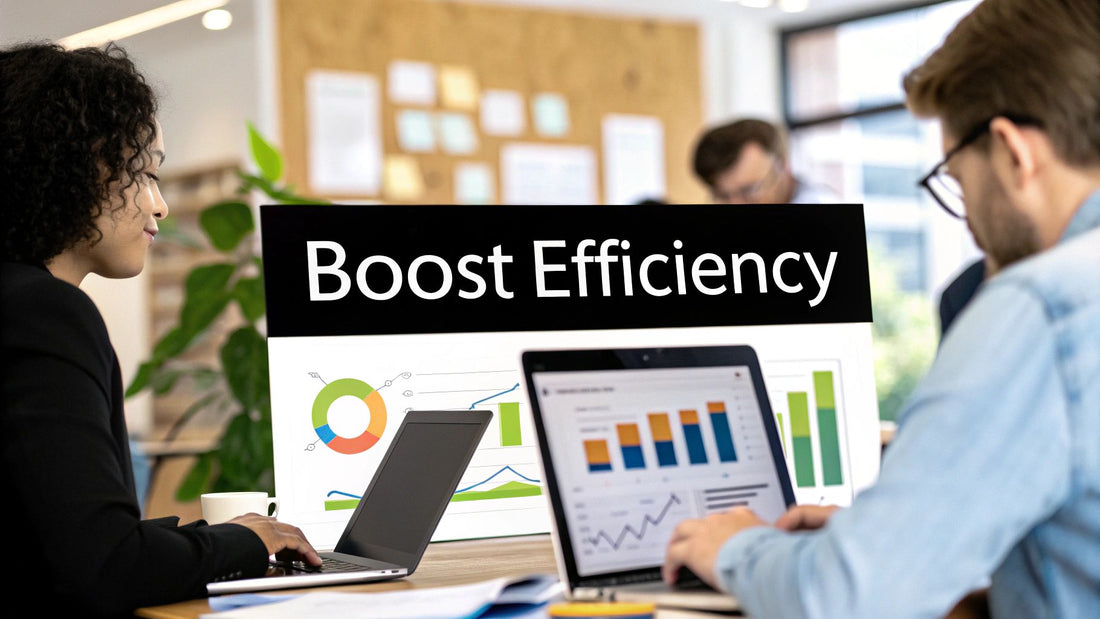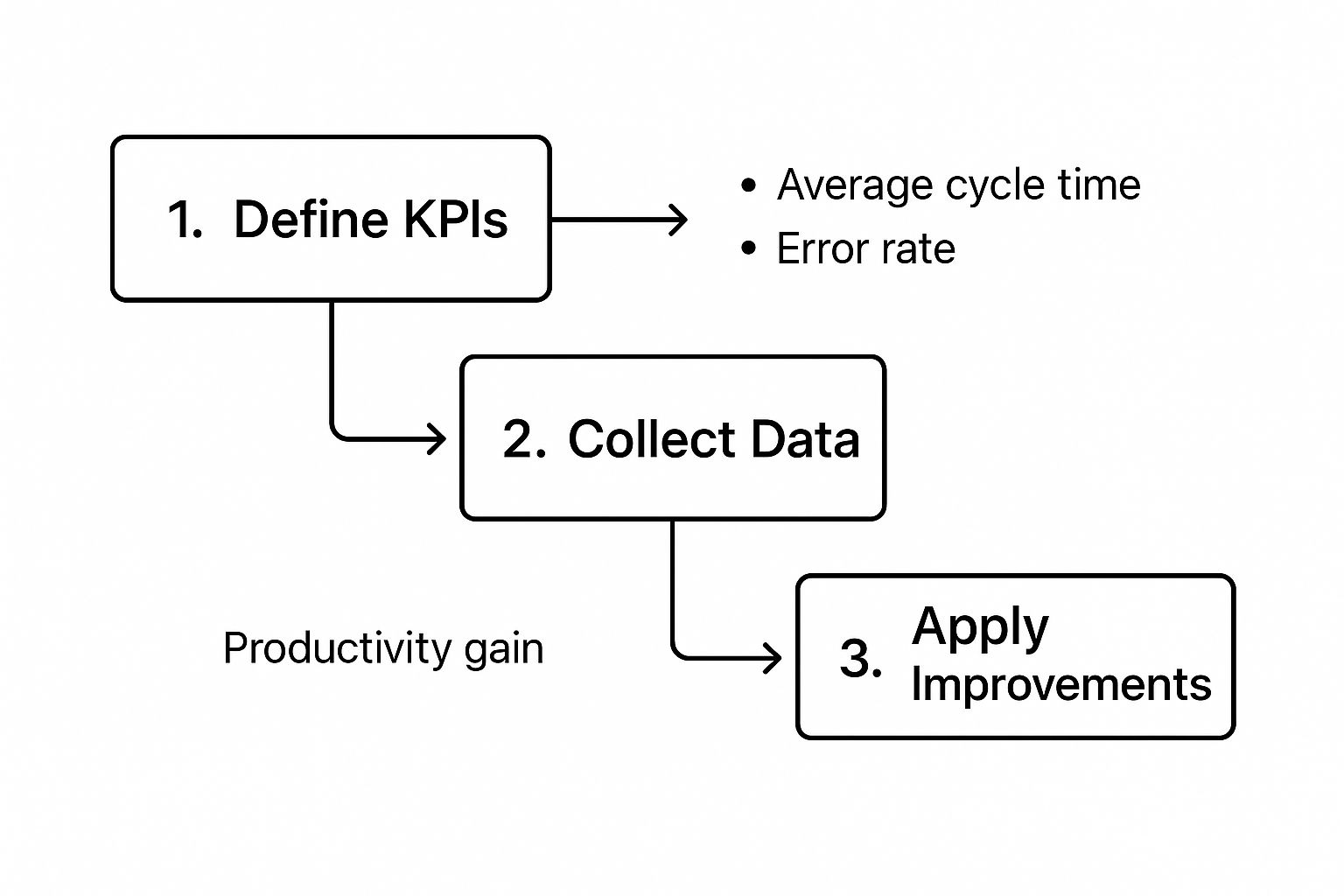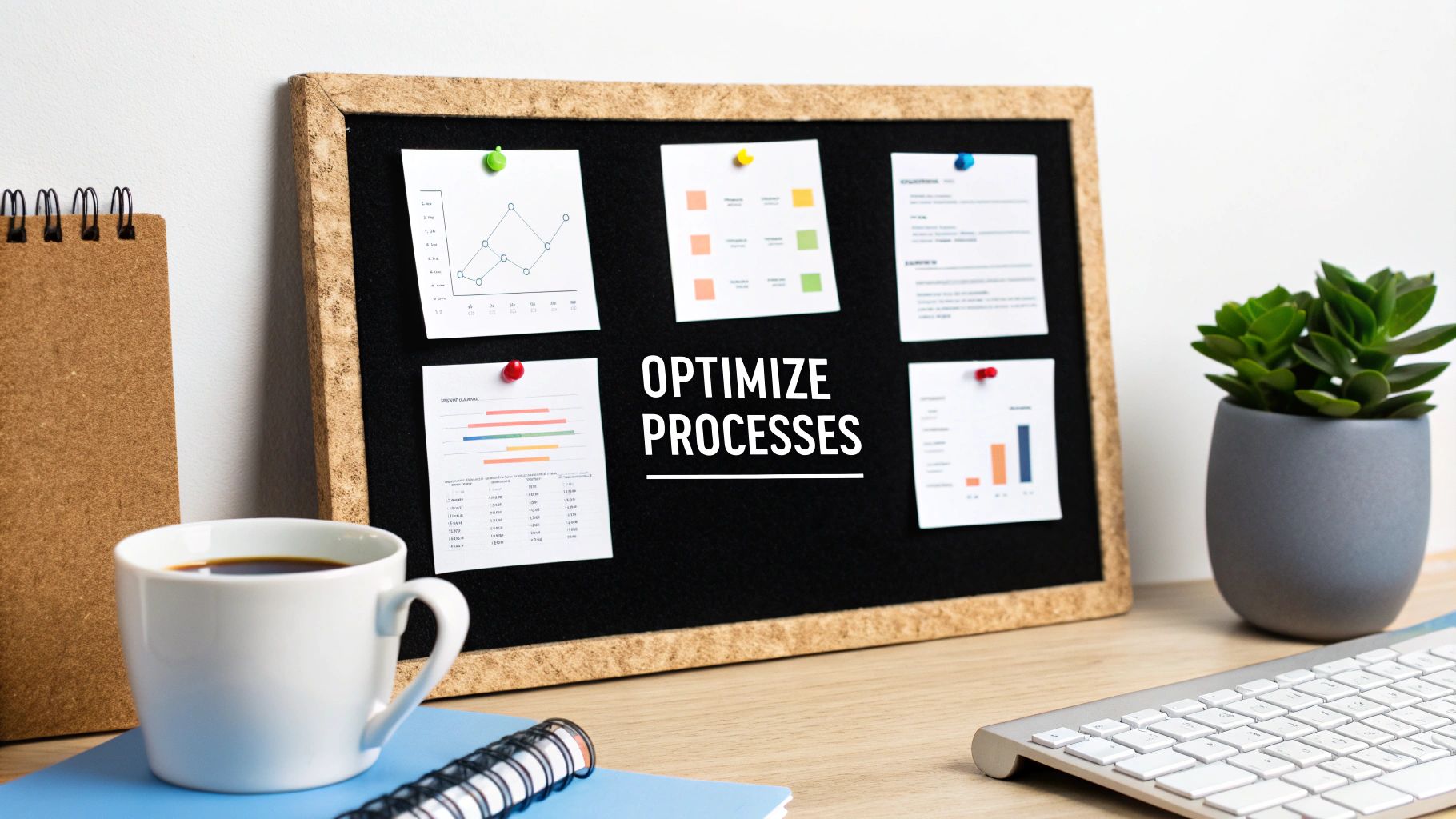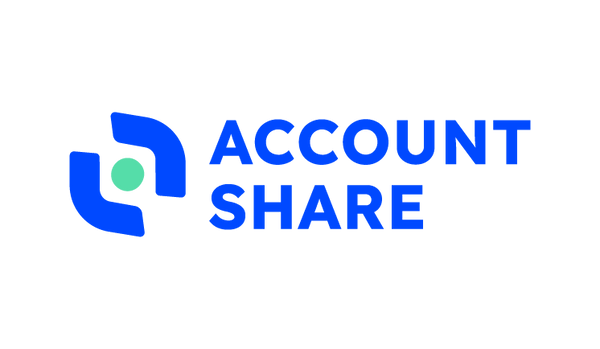
Boost Business Efficiency Improvement Strategies Today
Share
When we talk about improving business efficiency, it's not just about getting people to work faster. It’s a much bigger, more strategic idea. The real goal is to methodically root out and eliminate wasted time, money, and effort across your entire operation.
At its core, it means sharpening your processes, getting the most out of your resources, and smoothing out any friction that slows things down. Get this right, and you'll see a real impact on both productivity and profitability.
The True Cost of Inefficiency and How to Fight Back
Inefficiency is like a slow leak in your business—it drains resources quietly but constantly. You see it in the little things that add up: the mind-numbing administrative tasks, the money wasted on software subscriptions that don't talk to each other, and the momentum lost to clunky, disconnected workflows.
Every small bottleneck, every repeated manual entry, contributes to a much larger problem. It's what holds your company back from its true growth potential.
Think about the real hours your team burns just managing dozens of separate software accounts. Or the extra cash you spend when every department buys its own tools without a shred of coordination. From my experience, these aren't just minor headaches; they're direct hits to your bottom line and can seriously drag down team morale.
Unpacking the Hidden Costs
The real price tag on inefficiency goes way beyond what you see on a spreadsheet. It’s felt in very tangible ways:
- Wasted Hours: Every minute an employee spends on manual data entry or hunting for information across different platforms is a minute they're not spending on high-value, strategic work that actually brings in revenue.
- Overspending on Tools: Paying for multiple individual licenses for things like CRMs, design software, or SEO platforms is almost always more expensive than consolidating under a single, unified plan.
- Reduced Agility: When your systems are siloed, your ability to pivot and react to market changes grinds to a halt. This slow response time can put you miles behind your competition.
This push for operational excellence isn't just a niche idea anymore; it's a global movement. A recent study found that by 2025, a staggering 42% of organizations will have rolled out company-wide Operational Excellence (OPEX) strategies. Even more telling, nearly half (47%) see it as absolutely mission-critical for their success.
The secret to boosting business efficiency isn't about asking your team to work harder. It's about giving them smarter, more connected tools to do their best work.
Connecting Inefficiencies to Group Purchasing Solutions
It's one thing to spot the problems, but it's another to connect them to a practical solution. Group purchasing and shared accounts directly address these common pain points by turning isolated costs into collective strengths.
| Common Business Inefficiency | How Group Purchasing Solves It | Example Tool Category |
|---|---|---|
| Budget Overruns | Pools resources to unlock bulk discounts on premium plans, drastically cutting subscription costs. | SEO & Marketing Tools |
| Siloed Information | Centralizes access to a single, shared account, ensuring everyone works from the same data. | CRM & Sales Platforms |
| Administrative Overload | Eliminates the need to manage dozens of individual licenses, passwords, and billing cycles. | Design & Creative Software |
| Wasted Time | Provides the whole team with immediate access to powerful tools, removing purchase approval delays. | Project Management Systems |
This approach systematically converts everyday operational drags into powerful competitive advantages.
A Smarter Path Forward
So, instead of just pushing for more output, the real solution is to work smarter by tapping into collective power. This is exactly where strategies like group purchasing and shared accounts shine.
By pooling your resources, you can unlock major discounts on top-tier tools and centralize access for your entire team. This immediately cuts out redundant spending and slashes the administrative burden. It’s a strategy that goes straight to the root causes of inefficiency, turning what was once a huge cost center into a real source of strength.
To dig deeper into how you can fight back against these hidden costs, check out these 10 proven strategies to boost business efficiency with automation.
Finding Your High-Impact Group Purchasing Opportunities

Before you can boost your business's efficiency, you have to know exactly where your money is going. This isn’t about just glancing at your budget; it’s about rolling up your sleeves and doing a proper audit of your spending. Your goal is to find those specific subscriptions, services, and supplies that are perfect candidates for group purchasing.
A great place to start is by pulling a complete list of recurring expenses from your accounting software. Keep a close eye on your Software-as-a-Service (SaaS) subscriptions, as this is where the gold is often buried. It's truly amazing how many individual licenses for things like CRMs, project management platforms, or niche marketing tools can slip through the cracks.
Categorize and Analyze Your Spending
With your list in hand, it's time to get organized. Don’t just throw everything under a vague label like "Software." You need to get more specific.
Break it down into categories that make sense for your business, such as:
- SEO Tools
- Design Software
- Collaboration Platforms
- Cloud Storage
This kind of detailed breakdown is what helps you spot redundancies and find those big opportunities. For example, you might find that three different departments are all paying for separate, pricey SEO tool subscriptions. A single, top-tier enterprise plan could probably cover everyone for a fraction of the total cost.
When you see that kind of overlap, you've struck gold. This is more than just saving a few bucks; it’s a smart move that improves how your teams work together. For a deeper look at this, check out our guide to https://accountshare.ai/blogs/new/boost-your-business-with-collective-buying-power-strategies.
Real-World Scenario: I once worked with a mid-sized marketing agency where five different people were paying for their own premium accounts on a popular design platform. After a quick expense audit, they realized that by moving to a single "Teams" plan through a group buy, they could slash their monthly software bill by nearly 40%. Even better, it gave everyone access to shared asset libraries, which made a huge difference in how fast they could collaborate on projects.
Gather Usage Data and Team Feedback
The numbers only tell you half the story. The other half comes from your team. Once you've identified some potential tools for a group buy, you need to understand how they’re actually being used day-to-day. Many SaaS platforms have built-in analytics that can quickly show you if an expensive license is just sitting there collecting dust.
Talk to your team. A simple survey can work wonders. Ask them:
- Which tools could you absolutely not do your job without?
- Are there any features in your current tools you wish you had?
- Do you know if anyone else is using similar software for the same thing?
Their answers will either confirm what you've found or point you toward new savings you might have missed. It’s all part of the bigger picture of leveraging partnerships for growth and efficiency, which is a mindset that goes way beyond just cutting costs. This whole process gives you the information you need to make smart decisions that deliver a real return.
How Automation Streamlines Shared Account Access

Group purchasing is a smart way to cut costs, but the real game-changer is when you combine it with automation. This is the step that turns a simple discount strategy into a serious engine for business efficiency improvement. Without it, you’re just swapping high costs for a different problem: a massive administrative headache.
Picture this: you have a team of ten people sharing five different software tools. You'd be stuck in a constant loop of resetting passwords, updating spreadsheets, and answering "Hey, can you send me the login for X again?" requests. It's a logistical nightmare. Automation flips that entire script.
Platforms designed specifically for shared accounts, like AccountShare, do all the heavy lifting. They take over everything from adding new users to handing out credentials, turning what was once a chaotic, manual task into a smooth, hands-off workflow.
Get Rid of Manual Admin and Strengthen Security
The first thing you'll notice is how much time you get back. Instead of burning hours figuring out who has access to what, you can set up your rules once and let the system manage itself. This frees you and your team to focus on work that actually grows the business.
But the benefits run much deeper than just saving time. Let’s be honest, manual password sharing is a huge security risk. When you have passwords floating around in spreadsheets, emails, or chat threads, they're incredibly vulnerable. Automation puts a stop to that.
With a dedicated platform, the master credentials for each shared tool are locked away in a secure, centralized vault. Team members can log in, often through a browser extension, without ever seeing the actual password. This adds a powerful layer of security and gives you complete control. If you're looking to dive deeper into this, it's worth exploring the top advantages of process automation to see how it can truly reshape your operations.
Build an Efficiency Strategy That Lasts
Automation is what makes your group purchasing strategy truly scalable. Need to add a new team member or another shared tool? It’s a matter of a few clicks to grant or revoke access, not another hour of administrative work.
This scalability is key to making shared accounts a sustainable, long-term strategy for business efficiency. It ensures your process stays lean and efficient whether your team has five people or fifty.
This isn't just a niche idea; it's a global trend. Technologies like robotic process automation (RPA) are well-known for cutting operational costs. In some instances, a software robot costs just one-third of what an offshore employee does. What’s even better is that teams embrace it. Nearly 90% of employees trust automation to get tasks right, and 89% report feeling more satisfied at work when it's part of their day.
The goal isn't just to share accounts; it's to create a frictionless system where your team has instant, secure access to the tools they need to excel, without any of the administrative drag.
By automating how you manage access, you can:
- Onboard new users instantly: Grant access to all necessary tools in minutes, not hours or days.
- Revoke access securely: When someone leaves the company, you can cut off their access to every shared account with a single action.
- Maintain a clear audit trail: See exactly who accessed what and when, which is crucial for accountability and compliance.
Ultimately, automation takes group purchasing from a simple cost-saving trick and turns it into a strategic asset that boosts productivity, tightens security, and supports your company's growth.
Launching Your First Group Buy Like a Pro
Diving into group purchasing is one of the fastest ways to improve your business efficiency, but I know that first step can feel like a doozy. The trick is to treat it as a series of small, manageable tasks, not some massive, rigid project. Let’s walk through how to get that first group buy launched and make it a huge win.
Finding Your Founding Members
First things first, you need to identify the right people for your group. You can start small and look internally. For example, maybe both your marketing and sales departments are crying out for a premium CRM subscription they can't afford alone. That's a perfect internal group.
Alternatively, you can look outside your own walls to trusted businesses in your professional network. Think about other agencies, consultants, or friendly competitors who you know have similar needs. Don't just float a vague idea; reach out with a concrete proposal. Something like, "Hey, I'm putting a group together to buy the enterprise plan for this specific SEO tool. Are you interested in splitting the cost?" This makes it real and much easier for them to say yes.
Once you have a few interested parties, you can move on to the fun part: negotiating with the vendor. You’d be surprised how open they are to offering discounts when you come to them with a group of new customers.
Gearing Up for Vendor Negotiations
This is where your new collective buying power really shines. Before you even think about sending that first email, you need to do your homework. Get your facts straight:
- Know exactly how many total users your group represents.
- Decide on the specific subscription tier or plan you want.
- Have a target price or discount percentage in mind.
When you contact the vendor, frame it as a win-win. They get a handful of new, committed customers in one clean, easy transaction. You’re not just asking for a handout; you're offering them an efficient sale.
Remember, the point of negotiation isn't just about hammering down the price. It's about starting a relationship that benefits everyone. A great deal is one that feels fair to both sides and sets you up for future collaboration and even better service down the road.
This whole approach is part of a much bigger shift toward operational excellence. We're seeing it everywhere. Just look at the shared services market—a close cousin to group buying—which is on track to hit $111.26 billion by 2025. It's all fueled by a global push for digital transformation, with investments expected to top $2.5 trillion. These aren't just buzzwords; these models are proven to slash costs and dramatically improve how services are delivered. For a deeper dive, the latest 2025 GBS benchmarking report has some fascinating insights.
This continuous loop of measuring, analyzing, and acting is what drives real efficiency gains.

By keeping an eye on metrics like how long tasks take or your error rates, you get the hard data to prove that your new strategies are paying off.
Setting Up and Onboarding Your Team
Okay, you’ve secured the deal. Now for the final piece of the puzzle: getting everyone set up and using the tool.
This is where a platform like AccountShare becomes your best friend. It makes the technical side painless. You can configure the master account and then easily create specific roles and permissions for every single user. This gives everyone the access they need without you having to worry about security slip-ups. If you want a more detailed look, check out our complete guide on using group buying for business growth.
A smooth onboarding is absolutely critical. Don't just send an email and hope for the best. Schedule a quick kickoff meeting to walk everyone through the new workflow. Show them how to log in, point out the premium features they now have access to, and really sell the benefits. When your team understands why you've made this change, they'll be far more likely to jump on board, and those efficiency improvements you've been working toward will start to materialize.
Common Group Purchasing Mistakes and How to Avoid Them

While group purchasing can be a game-changer, I've seen plenty of businesses stumble by jumping in too quickly. A few common missteps can easily derail the cost savings and efficiency gains you're aiming for. The good news? With a bit of foresight, you can sidestep them entirely.
One of the classic blunders is getting into a group with the wrong people. If you team up with businesses that have spotty payment histories or totally different objectives, you're setting yourself up for an administrative nightmare. You need to vet your partners just as carefully as you would a new high-value client. My advice is to start small with a handful of people you already know and trust.
Another frequent oversight is the failure to establish clear rules of engagement from the get-go. Without a simple agreement on who uses the account, when, and for what, you're inviting chaos. This ambiguity often leads to overuse, which can get the account flagged or locked, or even worse, accidental data mix-ups.
Navigating Software License Agreements
This next one is the biggie: ignoring the fine print in software license agreements. I can't tell you how many times I've seen businesses start sharing an account, only to find out they’re violating the provider's terms of service (TOS). The consequence? An abrupt account suspension, cutting off access to a tool your team relies on daily.
Before you even think about sharing, you have to do your homework and dig into that license agreement. Look for specific language about:
- Permitted Users: Does the license strictly limit use to employees of one company? Or is it more flexible? Plans labeled "Team" or "Business" are often a good sign.
- Simultaneous Logins: Many vendors cap the number of devices that can be logged in at the same time. This could really throw a wrench in your group's workflow.
- Commercial Use: Double-check that the license allows for the kind of commercial work your group is doing.
The real goal here is to find software with plans built for collaboration. The best vendors get it—they understand that teams and partners need shared access, and they build their premium plans to accommodate that. A little proactive research here prevents a world of compliance headaches later.
This diligence is a critical piece of any smart cost-reduction plan. If you want to dive deeper, check out our guide on the top ways to reduce software costs and boost IT efficiency.
Setting Your Group Up for Success
Avoiding these mistakes really just boils down to solid preparation. A little planning ensures your group purchasing initiative leads to real business improvements, not a tangled mess of conflicts and compliance risks.
Here's a quick checklist to get you started on the right foot:
- Draft a Formal Group Agreement: It doesn't need to be overly complex. Just a simple document outlining each member's financial obligations, the rules for using the account, and an exit plan for when a member decides to leave.
- Assign a Central Administrator: Designate one person or business to be the official account manager. They'll handle the subscription payment and act as the main point of contact for the software vendor.
- Use a Management Platform: This is where a tool like AccountShare comes in. It's specifically built to manage shared access securely without ever exposing the master password, giving everyone the access they need without the inherent risk.
By thinking through these points upfront, you build a sturdy foundation for your purchasing group. You'll turn a good idea into a practical, sustainable strategy that actually works.
Answering Your Top Questions About Group Purchasing
When you first hear about group purchasing, it sounds like a brilliant way to boost efficiency and save money. But it's natural to have a few questions. I've seen countless business owners hesitate, wondering about the legal side, how to keep accounts safe, or even just how to manage it all.
Let's walk through the big three questions that come up time and time again. Getting these answers right is what separates a smart, long-term strategy from a short-lived headache.
Is Group Purchasing and Sharing Accounts Even Allowed?
This is the big one, and rightly so. The short answer is: it all comes down to the provider's terms of service (TOS). There's no gray area here; you have to be compliant.
Before you even think about sharing a tool, your first step is to dig into its license agreement. Many modern software companies get it—they offer "team" or "business" plans built specifically for multiple users. These are your green light. On the flip side, some tools strictly prohibit sharing a single-user license among different people or companies. Always do your homework before you buy.
Platforms like AccountShare are designed to navigate this. They typically focus on tools with plans that permit collective buying from the get-go. If you're teaming up with other businesses, your goal is to find a plan that explicitly allows it. When in doubt, a quick email to the vendor to clarify or negotiate a custom deal can save you a lot of trouble down the road.
How Do You Keep Shared Account Logins Secure?
Security is everything. I can't stress this enough: passing a master password around in emails, chats, or a shared spreadsheet is a recipe for disaster. It's an outdated practice that opens you up to huge risks. This is precisely why dedicated platforms are so crucial.
A proper, secure system doesn't share the password at all. Here’s how it works:
- The master password for the tool is locked away in a secure, encrypted vault.
- The end-users never actually see or handle the password.
- They log in automatically, usually through a secure browser extension.
This simple shift removes the single biggest point of failure—human error.
For your most critical accounts, make sure you can enable two-factor authentication (2FA) that's managed by one central administrator. It adds a powerful layer of defense. The whole idea is to centralize control and abstract the login process away from individual users.
This gives you total command. You can grant specific permissions to different users and, more importantly, instantly revoke access the moment someone leaves the group. It makes your setup both efficient and airtight.
What’s the Best Size for a Purchasing Group?
There isn't a single magic number here. The ideal group size really hinges on the tool you're buying and how its pricing is structured. If you're just sharing a tool within your own company, the answer is simple—it's the number of employees who need access.
When you start pooling funds with other businesses, things get a little more strategic.
- Small Groups (2-4 businesses): This is a fantastic way to start, especially with partners you already know and trust. The savings might not be massive, but the management is a breeze.
- Medium Groups (5-10 businesses): From my experience, this is often the sweet spot. You get enough buying power to unlock serious volume discounts without the logistics becoming overwhelming.
- Large Groups (11+ businesses): The savings potential here is huge, but so is the complexity. Without a rock-solid system and clear communication, large groups can quickly become chaotic.
My advice? Start small with a handful of trusted partners. Get your process down, find a good rhythm, and then grow from there. This slow-and-steady approach is the key to making group purchasing a sustainable win for your business.
Ready to unlock premium tools without the premium price tag? AccountShare makes it easy to leverage collective buying power, securely manage shared accounts, and boost your business efficiency. Join AccountShare today and start saving.
